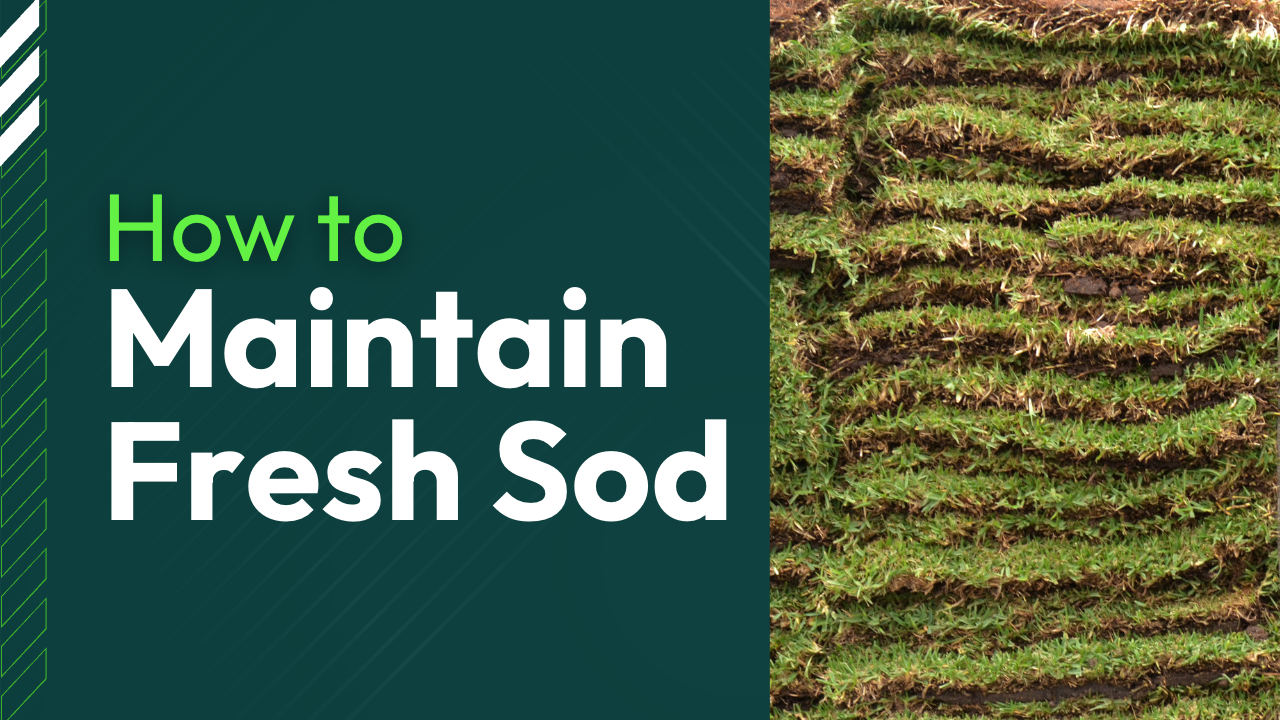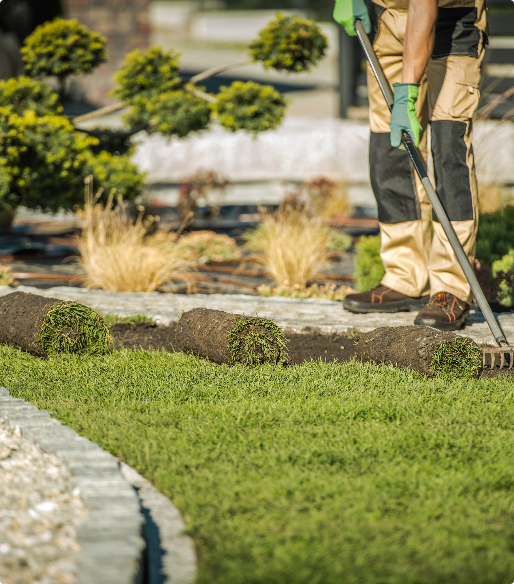

How to Maintain Fresh Sod A Step by Step Guide
Sod is a popular lawn care choice in south west Florida thanks to its ability to quickly transform your yard. If you are planning to install sod on your property, this blog provides tips and steps to ensure that the sod installation process goes smoothly, and you can maintain fresh sod in the weeks to come. From understanding what sod is to laying the sod itself, and choosing the best sod variety, this blog covers it all! So whether you’re new to sod or have been using it for years, make sure to check out this guide for tips and advice on how to care for fresh sod.
What is sod?
Sod is a type of grass that’s used to cover outdoor areas, and needs to be kept moist to stay healthy. If you’re new to sod, or just want to keep it in good condition, follow these four easy steps:
1. Choose the right sod – sod comes in a variety of types and colors, so it’s important to find the right one for your garden or patio.
2. Water sod regularly – sod needs water to stay healthy and look good. watering sod twice a week is usually enough.
3. Mow sod regularly – mowing sod lawns every two weeks will help to keep it in good condition and stop it from growing too tall.
4. Fertilize sod occasionally – fertilization helps sod to grow and look healthy. Apply fertilizer every two months or when the lawn starts to show signs of wear. With these simple steps, you’ll be able to maintain. Be sure to watch this video about using weed killer before laying sod.
How to Lay Sod
Sod installation is a breeze with the help of this guide. Start by removing any existing sod grass. Loosen the soil with a shovel or trowel until it is about a foot deep, then make an L-shape depression in the ground for the sod to sit in. Place the sod on top of the depression and press down firmly so that it sticks up slightly above ground level. Gently water your sod before you leave for work each day for the first few weeks – no need to water excessively! Once the sod is installed, fertilize it every two to three weeks with a fertilizer specifically formulated for sod, and water it lightly every day. Be patient – sod takes time to adjust to its new home, but once it does, you’ll be enjoying long-lasting sod that looks great and performs better than ever!
Maintain fresh sod by mowing
It’s important to keep your lawn looking good and healthy, no matter the season. That’s where mowing comes in – it’s a crucial step in the lawn care process that should be done on a regular basis to achieve the desired results. Here in south west Florida, we will be mowing year round. Keep in mind that mowing your lawn according to its thickness is important – short cuts will result in fresher looking turf but shorter lasting results overall. So, schedule your mowing schedule and get ready to take care of your lawn in the best way possible!
The Perfect Time to Mow and maintain fresh sod
The best time to mow your lawn is in the morning or evenings, when the sun is at its lowest. Leave a 1/4-1/2 inch of grass at the edge of the lawn so that it will regrow quickly. Over-mowing your lawn can lead to erosion and decreased landscaping value.
How Much Grass to Cut
There’s no need to worry about mowing the lawn incorrectly – follow these simple steps and you’ll be able to get the job done perfectly every time. And if watering is something that falls outside of your regular routine, don’t forget to do it on a regular basis! Raking up leaves or debris will also help keep your lawn looking its best.
How soon do you mow fresh new sod
Mowing fresh new sod is an important task that needs to be done as soon as it’s ready. The grass should be mowed approximately 2-3 weeks after planting, using a rotary or string trimmer. Make sure to adjust the blade height and width according to your lawn type and condition – this will ensure a neat finish every time. You should also sharpen the blades on a regular basis in accordance with the manufacturer’s instructions.
How to maintain fresh sod by watering
When it comes to sod, watering is definitely the most important step. It’s important to water sod slowly and evenly to avoid creating puddles. And make sure to water the sod thoroughly until all the water is absorbed, avoiding over-irrigation. If you notice any pests on or around the sod, take the appropriate measures to get rid of them. Finally, make sure to irrigate each square of sod thoroughly until all the water is absorbed, to avoid any root damage. Keep sod healthy and happy by watering it in a way that suits your garden’s watering schedule and climate!
New sod watering techniques
Watering sod is a continuous process that requires patience and care. Follow the proper watering techniques to ensure healthy roots and a long life for the plant. water sod slowly and deeply, making sure to saturate the soil . Water sod in the morning and at night, when the sun is not on it. Make sure to water from top of sod downwards- this will help avoid root rot . Never over water sod – this can cause Sod to die prematurely use hose with poor flow rate – Sod will get parched quickly.
How much water to give sod
There is no single answer to the question of how much water to give sod. It will depend on the type of soil and climate, as well as the sod’s growing conditions. So, you’ll need to check the soil consistency and watering schedule accordingly. It’s important to water sod regularly – usually once a week in early stages and then every 2-3 weeks as it grows taller. If your sod is located in an area that gets a lot of rain, you may only need to water it once a month or even less! However, don’t over water sod – this could lead to root rot and ultimately the death of your plant. Daily monitoring of soil moisture levels is also essential – if necessary, adjust watering accordingly.”
When to water sod
It is important to water sod every day during the dry season, even if it doesn’t look like the ground has been wet recently. Sod takes up to 2 weeks to rehydrate so be patient. Wet sod will feel spongy and slimy – this is normal. Make sure you water it evenly – do not over water it or leave pools of water.
Tips for preventing dry soil
Preventing dry grass patches is easy if you follow the tips outlined here. Watering sod regularly, making sure the water reaches down deep into the ground, and raking sod to remove dried leaves and debris will go a long way in keeping your lawn healthy and moist.
Frequently Asked Questions
What are some tips for keeping my sod healthy and flourishing?
There are a few tips for keeping sod healthy and flourishing: water it properly, mulch it, and fertilize it. Sod is a living plant, so take care of it the same way you would treat any other living plant in your garden!
Is there anything else that I need to take into account when caring for fresh sod?
Here are a few additional tips for caring for fresh sod:
- Sod needs proper drainage – make sure to place the sod in a location that has good soil and drainage.
- Feed the plant with an all-purpose fertilizer every 3 months during the spring, summer and fall seasons.
- Make sure to water your fresh sod well but avoid over watering; this could result in root rot.
Does regular maintenance help maintain my sod’s freshness or should I do this every week, or even more frequently than that?
Keeping the freshness of your sod lawn is important not only for the appearance of it, but for its overall health as well. To do this, follow these simple steps:
1. Rake up any leaves or debris every week. This will help to clear the lawn of any debris and leaves, and keep the soil loose so that water can reach the root system easily.
2. Water regularly – let the water run through the topsoil at least once a day. This will help to keep the lawn moist and prevent the roots from drying out.
3. Mulch around the base of the plant every 2 to 3 months. This will help to retain moisture in the soil and protect the sod against potential drought or cold temperatures.
Conclusion
Sod is the perfect landscaping solution for areas that receive a lot of sunlight, such as the front of your home. sod is drought-tolerant and requires very little watering, making it a sustainable option. In this blog, we walk you through the process of laying sod, providing tips on how to maintain it and answer common questions. Get ready to enjoy gorgeous sod in your landscaping!
Whether you live in Odessa, Fort Myers, or any other south west Florida area, Call or Text our Smart Sod Customer Care Team at (816) 852-3862 or visit one of our retail locations to learn more about the sod varieties we offer in south west Florida.

